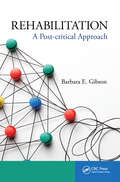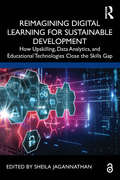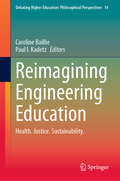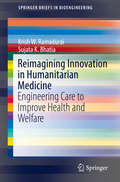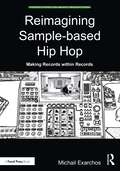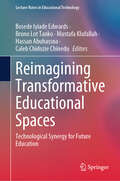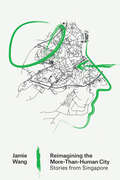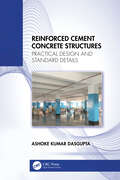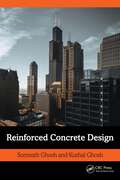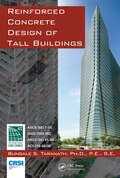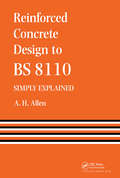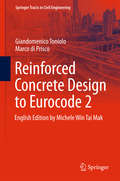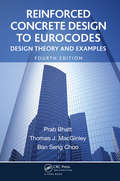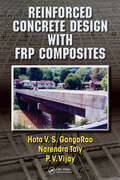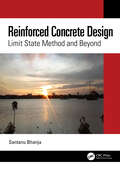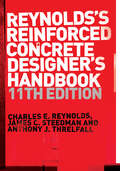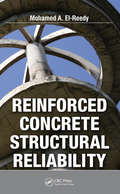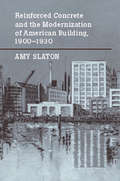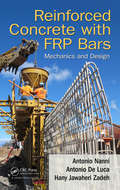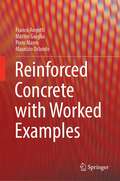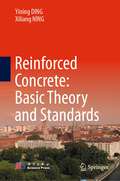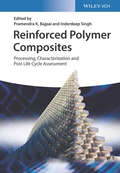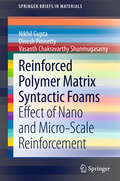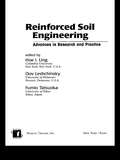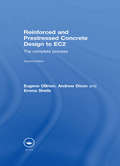- Table View
- List View
Rehabilitation: A Post-critical Approach (Rehabilitation Science In Practice Series)
by Barbara GibsonRehabilitation is dedicated to helping people not only survive, but also thrive. Despite this complex goal, the organizing principles of rehabilitation still rely on biomedicine to construct disability as a problem of impaired bodies. Rehabilitation professionals are committed to helping to enhance people's lives, but many struggle with how to do s
Reimagining Digital Learning for Sustainable Development: How Upskilling, Data Analytics, and Educational Technologies Close the Skills Gap
by Sheila JagannathanReimagining Digital Learning for Sustainable Development is a comprehensive playbook for education leaders, policy makers, and other key stakeholders leading the modernization of learning and development in their institutions as they build a high value knowledge economy and prepare learners for jobs that don't yet exist. Currently, nearly every aspect of human activity, including the ways we absorb and apply learning, is influenced by disruptive digital technologies. The jobs available today are no longer predicators of future employment, and current and future workforce members will need to augment their competencies through a lifetime of continuous upskilling and reskilling to meet the demands of the Fourth Industrial Revolution. This book features curated insights and real-world cases from thought leaders throughout the world and identifies major shifts in content formats, pedagogic approaches, technology frameworks, user and design experiences, and learner roles and expectations that will reshape our institutions, including those in emerging economies. The agile, lean, and cost-effective strategies proposed here will function in scalable and flexible bandwidth environments, enabling education leaders and practitioners to transform brick-and-mortar learning organizations into digital and blended ecosystems and to achieve the United Nation’s ambitious Sustainable Development Goals by 2030.
Reimagining Engineering Education: Health. Justice. Sustainability. (Debating Higher Education: Philosophical Perspectives #14)
by Caroline Baillie Paul I. KadetzThis book considers a radical change to engineering education. It argues for a reexamination of the traditional way in which engineering students are educated in disciplinary silos and how, instead, we might re-imagine their professional education to more appropriately prepare students to design innovative solutions to increasingly complex global challenges. It poses the question: “How can engineers think outside the engineers’ box?". A box that has over generations rendered engineers to be unquestioning servants of the socio-political systems in which they function. The book introduces a unique framework and language for engineering education which considers both the problems of the past and present, and the potential solutions offered for the future. By reaching out beyond the bounds of traditional knowledge and thought collectives, this book will also offer a pathway for other professional education programs to explore.
Reimagining Innovation in Humanitarian Medicine: Engineering Care to Improve Health and Welfare (SpringerBriefs in Bioengineering)
by Sujata K. Bhatia Krish W. RamaduraiThroughout history, humanity has been plagued by a myriad of humanitarian crises that seemingly take the form of perpetual human suffering. Today, approximately 125,000,000 people require humanitarian assistance as the result of famine, war, geopolitical conflict, and natural disasters. A core component of this suffering is afflictions related to human health, where disturbances strain or overwhelm the existing healthcare infrastructure to create the conditions for an increase in morbidities and co-morbidities. One of the more startling elements is the loss of life to preventable medical conditions that were not properly treated or even diagnosed in the field, and is often due to the limited interventional capacity that medical teams and humanitarian practitioners have in these scenarios. These individuals are often hindered by medical equipment deficiencies or devices not meant to function in austere conditions. The development of highly versatile, feasible, and cost-effective medical devices and technologies that can be deployed in the field is essential to enhancing medical care in unconventional settings. In this book we examine the nature of the creative problem-solving paradigm, and dissect the intersection of frugal, disruptive, open, and reverse innovation processes in advancing humanitarian medicine. Specifically, we examine the feasible deployment of these devices and technologies in unconventional environments not only by humanitarian aid and disaster relief agencies, but also by crisis-affected communities themselves. The challenge is complex, but the financial support and technical development of innovative solutions for the delivery of humanitarian aid is a process in which everyone is a stakeholder.
Reimagining Sample-based Hip Hop: Making Records within Records (Perspectives on Music Production)
by Michail ExarchosReimagining Sample-based Hip Hop: Making Records within Records presents the poetics of hip-hop record production and the significance of sample material in record making, providing analysis of key releases in hip-hop discography and interviews with experts from the world of Hip Hop and beyond. Beginning with the history of hip-hop music making, this book guides the reader through the alternative techniques deployed by beat-makers to avoid the use of copyrighted samples and concludes with a consideration of the future of Hip Hop, alongside a companion album that has been created using findings from this research. Challenging previous theoretical understandings about Hip Hop, the author focuses on deconstructing sonic phenomena using his hands-on engineering expertise and in-depth musicological knowledge about record production. With a significant emphasis on both practice and theory, Reimagining Sample-based Hip Hop will be of interest to advanced undergraduates, postgraduates, and researchers working in audio engineering, music production, hip-hop studies, and musicology.
Reimagining Transformative Educational Spaces: Technological Synergy for Future Education (Lecture Notes in Educational Technology)
by Bosede Iyiade Edwards Bruno Lot Tanko Mustafa Klufallah Hassan Abuhassna Caleb Chidozie ChineduThis book explores the symbiotic relationship between human learning and machine learning, examining how emerging technologies and human–machine interfaces are reshaping the educational landscape. Organized into four sections with 20 chapters, it provides a multidisciplinary perspective on the dynamic intersection of these twin concepts. Bridging theory and practical implementation, the book goes beyond theoretical foundations, offering actionable strategies for educators, policymakers, and institutions to harness the transformative power of technology enhanced learning. This book showcases the impact of these innovations on human learning and machine learning, which is particularly relevant for developing and transition nations. Enriched with case studies, empirical research, and data-driven insights, it serves as a comprehensive guide for understanding and navigating the evolving landscape where human learning and machine learning converge.
Reimagining the More-Than-Human City: Stories from Singapore (Urban and Industrial Environments)
by Jamie WangAn exploration of the multifaceted urban environmental issues in Singapore through a more-than-human lens, calling for new ways to think of and story cities.As climate change accelerates and urbanization intensifies, our need for more sustainable and livable cities has never been more urgent. Yet, the imaginary of a flourishing urban ecofuture is often driven by a specific version of sustainability that is tied to both high-tech futurism and persistent economic growth. What kinds of sustainable futures are we calling forth, and at what and whose expense? In Reimagining the More-Than-Human City, Jamie Wang attempts to answer these questions by critically examining the sociocultural, political, ethical, and affective facets of human-environment dynamics in the urban nexus, with a geographic focus on Singapore.Widely considered a model for the future of urbanism and an emblematic new world city, Singapore, Wang contends, is a fascinating site to explore how modernist sustainable urbanism is imagined and put into practice. Drawing on field research, this book explores distinct and intrarelated urban imaginaries situated in various sites, from the futuristic, authoritarian Supertree Grove, positioned as a technologically sustainable solution to a velocity-charged and singular urban transportation system, to highly protected nature reserves and to the cemeteries, where graves and memories continue to be exhumed and erased to make way for development. Wang also attends to more contingent yet hopeful alternatives that aim to reconfigure current urban approaches. In the face of growing enthusiasm for building high-tech, sustainable, and &“natural&” cities, Wang ultimately argues that urban imaginings must create space for a more relational understanding of urban environments.
Reinforced Cement Concrete Structures: Practical Design and Standard Details
by Ashoke Kumar DasguptaThis book aims to provide actual methods of calculation and standard details followed by professionals in industrial projects pertaining to Reinforced Cement Concrete (RCC) structures backed by practical design and standard details. It covers the engineering properties of soil and types of tests, different types of concrete grades, standard notes and codes, and workout examples of piles, foundations and superstructure elements. It provides all of the standard construction details, including reinforcement arrangements, generally used for RCC works in superstructures and foundations.Features: Provides the strength design calculation for foundation and settlement analysis of the founding soil together Discusses standard details of reinforced concrete joints and reinforcement placement Describes suitable types of material and selection of structure according to the nature of the founding soil and service life of the plant Explores standard construction details Includes solved problems, design and workout examples as per Indian and US standards This book is aimed at professionals in construction, structural and civil engineering.
Reinforced Concrete Design
by Somnath Ghosh Kushal GhoshThis book explains behavioral aspects of Reinforced Concrete (RCC) structures along with brief research to understand the codal recommendations in different countries. Related issues of RCC design are also discussed and these are supplemented by numerical/design examples and fundamental review questions in each chapter. The subject matter in this book also critically discusses the considerations for non-elastic behavior in design procedures to accommodate design objectives. A comparison of design methodology and output as per IS, BS, EURO and ACI Codes is also included.Features: Covers the basic behavioral aspects of reinforced concrete structures Includes design examples to understand the theoretical concepts of different modules Discusses considerations for non-elastic behavior for making simple design procedures to accommodate design objectives within codal provisions Provides the basic insights necessary for effective development of a design Includes a number of design examples along with working drawings This book is aimed at researchers; professionals; graduate students in RCC structures, civil and infrastructure engineering; and those involved in project execution and consultancy firms.
Reinforced Concrete Design of Tall Buildings
by Bungale S. TaranathAn exploration of the world of concrete as it applies to the construction of buildings, Reinforced Concrete Design of Tall Buildings provides a practical perspective on all aspects of reinforced concrete used in the design of structures, with particular focus on tall and ultra-tall buildings. Written by Dr. Bungale S. Taranath, this work explains t
Reinforced Concrete Design to BS 8110 Simply Explained
by A. AllenThis highly successful book describes the background to the design principles, methods and procedures required in the design process for reinforced concrete structures. The easy to follow style makes it an ideal reference for students and professionals alike.
Reinforced Concrete Design to Eurocode 2
by Giandomenico Toniolo Marco Di PriscoThis textbook describes the basic mechanical features of concrete and explains the main resistant mechanisms activated in the reinforced concrete structures and foundations when subjected to centred and eccentric axial force, bending moment, shear, torsion and prestressing,. It presents a complete set of limit-state design criteria of the modern theory of RC incorporating principles and rules of the final version of the official Eurocode 2. This textbook examines methodological more than notional aspects of the presented topics, focusing on the verifications of assumptions, the rigorousness of the analysis and the consequent degree of reliability of results. Each chapter develops an organic topic, which is eventually illustrated by examples in each final paragraph containing the relative numerical applications. These practical end-of-chapter appendices and intuitive flow-charts ensure a smooth learning experience. The book stands as an ideal learning resource for students of structural design and analysis courses in civil engineering, building construction and architecture, as well as a valuable reference for concrete structural design professionals in practice.
Reinforced Concrete Design to Eurocodes: Design Theory and Examples, Fourth Edition
by Prab Bhatt Ban Seng Choo T.J. MacGinleyThis fourth edition of a bestselling textbook has been extensively rewritten and expanded in line with the current Eurocodes. It presents the principles of the design of concrete elements and of complete structures, with practical illustrations of the theory. It explains the background to the Eurocode rules and goes beyond the core topics to cover the design of foundations, retaining walls, and water retaining structures. The text includes more than sixty worked out design examples and more than six hundred diagrams, plans, and charts. It suitable for civil engineering courses and is a useful reference for practicing engineers.
Reinforced Concrete Design with FRP Composites
by Hota V.S. GangaRao Narendra Taly P. V. VijayAlthough the use of composites has increased in many industrial, commercial, medical, and defense applications, there is a lack of technical literature that examines composites in conjunction with concrete construction. Fulfilling the need for a comprehensive, explicit guide, Reinforced Concrete Design with FRP Composites presents specific informat
Reinforced Concrete Design: Limit State Method and Beyond
by Santanu BhanjaReinforced Concrete Design (RC) is performed mostly by the limit state method throughout the world. This book covers the fundamental concepts and principles of RC design developing the topics from the basic theories and assumptions. Building upon the possible revisions to the mother code of concrete in India, IS:456-2000, it explains the RC design provisions of IRC:112-2020, which are in line with international standards. In addition to strength design, serviceability and ductility design are also covered.Features: Highlights the basic philosophy of RC design and behaviour of the sections up to and beyond limit state. Clarifies limit state theory from the basic assumptions provided in relevant Indian and international standards, IS:456, IRC:112 and Eurocode:2. Includes design aids or tools for standard and high strength concrete up to M90 grade as per different codes of practice. Explains the concept of ductility of reinforced concrete sections subjected to flexure with or without axial loads from fundamental principles. Covers fundamentals on serviceability requirements in reinforced concrete structures. Illustrates the design methodology of shear walls and includes design aids developed using basic principles as per relevant codes of practice. Explains reinforced concrete design provisions as per latest national and international standards and these are expected to be in line with those to be included in the forthcoming revision of IS:456. This book is aimed at graduate students, researchers and professionals in civil engineering, construction engineering and concrete.
Reinforced Concrete Designer's Handbook
by Charles E. Reynolds James C. Steedman Anthony J. ThrelfallThis classic and essential work has been thoroughly revised and updated in line with the requirements of new codes and standards which have been introduced in recent years, including the new Eurocode as well as up-to-date British Standards. <P><P> It provides a general introduction along with details of analysis and design of a wide range of structures and examination of design according to British and then European Codes. <P><P> Highly illustrated with numerous line diagrams, tables and worked examples, Reynolds's Reinforced Concrete Designer's Handbook is a unique resource providing comprehensive guidance that enables the engineer to analyze and design reinforced concrete buildings, bridges, retaining walls, and containment structures. <P><P> Written for structural engineers, contractors, consulting engineers, local and health authorities, and utilities, this is also excellent for civil and architecture departments in universities and FE colleges.
Reinforced Concrete Structural Reliability
by Ph.D, Mohamed El-ReedyStructural engineers must focus on a structure's continued safety throughout its service life. Reinforced Concrete Structural Reliability covers the methods that enable engineers to keep structures reliable during all project phases, and presents a practical exploration of up-to-date techniques for predicting the lifetime of a structure. The book a
Reinforced Concrete and the Modernization of American Building, 1900-1930 (Johns Hopkins Studies in the History of Technology)
by Amy E. SlatonExamining the proliferation of reinforced-concrete construction in the United States after 1900, historian Amy E. Slaton considers how scientific approaches and occupations displaced traditionally skilled labor. The technology of concrete buildings—little studied by historians of engineering, architecture, or industry—offers a remarkable case study in the modernization of American production.The use of concrete brought to construction the new procedures and priorities of mass production. These included a comprehensive application of science to commercial enterprise and vast redistributions of skills, opportunities, credit, and risk in the workplace. Reinforced concrete also changed the American landscape as building buyers embraced the architectural uniformity and simplicity to which the technology was best suited. Based on a wealth of data that includes university curricula, laboratory and company records, organizational proceedings, blueprints, and promotional materials as well as a rich body of physical evidence such as tools, instruments, building materials, and surviving reinforced-concrete buildings, this book tests the thesis that modern mass production in the United States came about not simply in answer to manufacturers' search for profits, but as a result of a complex of occupational and cultural agendas.
Reinforced Concrete with FRP Bars: Mechanics and Design
by Antonio Nanni Antonio De Luca Hany Jawaheri ZadehCorrosion-resistant, electromagnetic transparent and lightweight fiber-reinforced polymers (FRPs) are accepted as valid alternatives to steel in concrete reinforcement. Reinforced Concrete with FRP Bars: Mechanics and Design, a technical guide based on the authors more than 30 years of collective experience, provides principles, algorithms, and pr
Reinforced Concrete with Worked Examples
by Franco Angotti Matteo Guiglia Piero Marro Maurizio OrlandoThis textbook describes the design of reinforced and prestressed concrete structures according to the latest advances both in the field of materials, concrete and steel, and in the field of structural analysis. These advances have been included in current version of Eurocode 2, which is taken as reference. All subjects are presented starting from their theoretical bases and passing to corresponding EC2 formulations. A large part of the book is concerned with the most innovative EC2 parts, like nonlinear structural analyses, second-order effects, punching and strut-and-tie models. The textbook is equipped with numerous worked examples, useful for the reader who is not familiar with the design of reinforced and prestressed concrete structures by the Limit State Method. Examples have been chosen among the most frequent cases of the professional practice. Thanks to this structure, it can be of interest both to structural designers for their professional training and to students of engineering and architecture schools for their studies. The volume contains twelve chapters, which follow the same structure of EC2, except for chapter 6 (dealing with prestressed concrete structures), which does not match any chapter of EC2, as prestressed concrete is considered in EC2 as a particular case of reinforced concrete, and corresponding formulations are shed over different chapters.
Reinforced Concrete: Basic Theory and Standards
by Yining DING Xiliang NINGThis book is intended to establish a bridge between the GB 50010, Fib MC2010, BS 8110 and ACI 318 or EC2. The respective pros and cons of different theories and methods according to various standards are compared or analyzed. Undergraduate and graduate students, foreign exchange students of international classes at Chinese universities who desire to work in China, or who are willing to work abroad in the field of civil engineering can benefit from the book. As such, this book provides valuable knowledge and useful design methods based on the different theories or guidelines.
Reinforced Polymer Composites: Processing, Characterization and Post Life Cycle Assessment
by Inderdeep Singh Pramendra K. BajpaiPresents state-of-the-art processing techniques and readily applicable knowledge on processing of polymer composites The book presents the advancement in the field of reinforced polymer composites with emphasis on manufacturing techniques, including processing of different reinforced polymer composites, secondary processing of green composites, and post life cycle processing. It discusses the advantages and limitations of each processing method and the effect of processing parameters on the overall performance of the composites. Characterization and applications of reinforced polymer composites are also introduced. Reinforced Polymer Composites: Processing, Characterization and Post Life Cycle Assessment starts off by providing readers with a comprehensive overview of the field. It then introduces them to the fabrication of both short fiber/filler reinforced polymer composites and laminated reinforced polymer composites. Next, it takes them through the processing of polymer-based nanocomposites; the many advances in curing methods of reinforced polymer composites; and post life cycle processing, re-processing, and disposal mechanisms of reinforced polymer composites. Numerous other chapters cover: synthetic versus natural fiber reinforced plastics; characterization techniques of reinforced plastics; friction and wear analysis of reinforced plastics; secondary processing of reinforced plastics; and applications of reinforced plastics. -Presents the latest development in materials, processing, and characterization techniques, as well as applications of reinforced polymer composites -Guides users in choosing the best processing methods to produce polymer composites and successfully manufacture high quality products -Assists academics in sorting out basic research questions and helps those in industry manufacture products, such as marine, automotive, aerospace, and sport goods Reinforced Polymer Composites: Processing, Characterization and Post Life Cycle Assessment is an important book for materials scientists, polymer chemists, chemical engineers, process engineers, and anyone involved in the chemical or plastics technology industry.
Reinforced Polymer Matrix Syntactic Foams
by Nikhil Gupta Dinesh Pinisetty Vasanth Chakravarthy ShunmugasamyReinforced Syntactic Foams: Effect of Nano and Micro-Scale Reinforcement examines the fabrication processes, mechanism of reinforcement, and structure-property correlations of reinforced syntactic foams. The authors present the state of the art in this field, compare the properties of various types of syntactic foam systems comprising different matrix, hollow particle, and reinforcement materials. The book further identifies theories useful in predicting the properties of reinforced syntactic foams and conducting parametric studies to understand the possibility for tailoring their properties.
Reinforced Soil Engineering: Advances in Research and Practice (Civil And Environmental Engineering Ser. #Vol. 14)
by Hoe I. Ling Dov Leshchinsky Fumio TatsuokaThis one-of-a-kind reference evaluates the efficacy, stability, and strength of various soil walls, slopes, and structures enhanced by geosynthetic materials. Offering stimulating contributions from more than 50 leading specialists in the field, Reinforced Soil Engineering compiles recent innovations in design layout, controlled construction, and geosynthetic material implementation for improved cost-efficiency, maintenance, and functioning in civil engineering applications. The book focuses on geotechnical earthquake issues and case histories from countries including the United States, Canada, Japan, Taiwan, Turkey, and other European nations.
Reinforced and Prestressed Concrete Design to EC2: The Complete Process, Second Edition
by Eugene Obrien Andrew Dixon Emma SheilsConcrete is an integral part of twenty-first century structural engineering, and an understanding of how to analyze and design concrete structures is a vital part of training as a structural engineer. With Eurocode legislation increasingly replacing British Standards, it’s also important to know how this affects the way you can work with concrete. Newly revised to Eurocode 2, this second edition retains the original’s emphasis on qualitative understanding of the overall behaviour of concrete structures. Now expanded, with a new chapter dedicated to case studies, worked examples, and exercise examples, it is an even more comprehensive guide to conceptual design, analysis, and detailed design of concrete structures.The book provides civil and structural engineering students with complete coverage of the analysis and design of reinforced and prestressed concrete structures. Great emphasis is placed on developing a qualitative understanding of the overall behaviour of structures.
